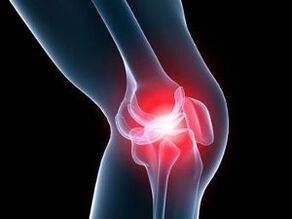
Osteoarthritis is a joint disease that is associated with damage to the cartilage tissue. Synonyms for arthrosis are gonarthrosis, deforming osteoarthrosis, arthrosis - all these terms mean the development of degenerative processes in the cartilage that covers the epiphyses of the articular bones.
Although the lesion affects only the cartilaginous structures, all articular elements are affected - the capsule, the synovial membrane, the subchondral bones, as well as the ligaments and muscles surrounding the joint. Osteoarthritis can affect one or more joints.
The most common localized forms of the disease have their own names: arthrosis of the hip joint is called coxarthrosis, arthrosis of the knee joint is called gonarthrosis.
Classification and reasons
Knee osteoarthritis can be primary or secondary. The first group includes pathologies whose cause is not clear, i. e. H. they are idiopathic in nature. Secondary arthrosis occurs after injuries, due to congenital anomalies and against the background of systemic diseases.
The causes of osteoarthritis of the knee joint are:
- Autoimmune diseases – rheumatoid arthritis, lupus erythematosus, scleroderma, etc. ;
- Inflammation of the joints caused by a certain infection (syphilis, gonorrhea, encephalitis);
- Hereditary diseases of the musculoskeletal system and joints, type 2 collagen mutations.
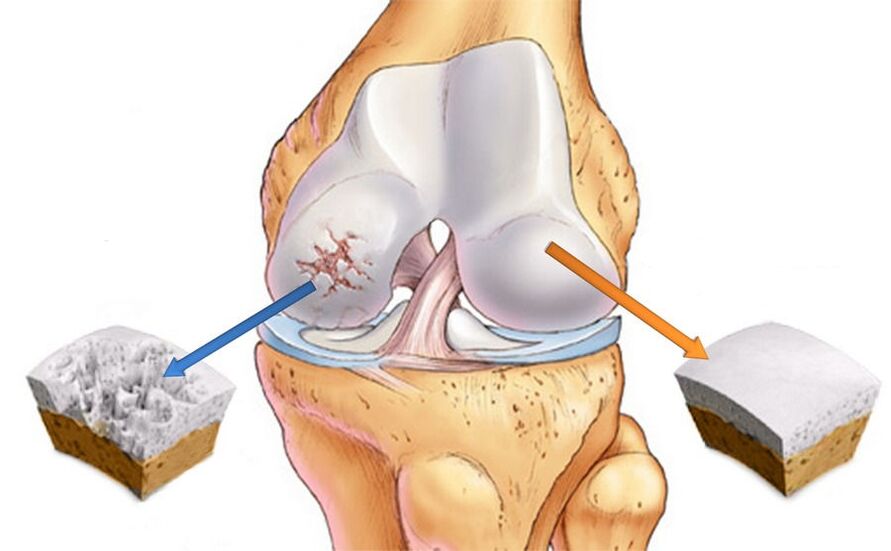
There are also a number of factors that can negatively affect the joints and cause pathological changes in them:
- age, obesity, osteoporosis;
- hormonal changes, including a decrease in estrogen synthesis during the postmenopausal period in women;
- metabolic disease;
- Lack of microelements and vitamins in the diet;
- congenital and acquired deformities of skeletal bones;
- hypothermia and poisoning with toxic compounds;
- constant injury to the joint during sports training or hard work;
- Operations on the knee joint – for example to remove the meniscus.
Symptoms and stages
Deforming arthrosis of the knee joint is characterized by intracellular changes at the morphological, molecular, biochemical and biomechanical levels. The consequence of the pathological process is softening, fibrillation and reduction in the thickness of the articular cartilage. In addition, the surfaces of the joint-forming bones become denser and bone spines - osteophytes - form on them.
DOA of the knee joints develops in three stages and in the early stages can cause only mild pain and discomfort after prolonged physical activity. Sometimes one of the characteristic symptoms of osteoarthritis occurs - morning stiffness. At this time, changes occur in the synovial membrane and the composition of the intra-articular fluid.
As a result, the cartilage tissue does not receive enough nutrients and its compressive strength decreases. Therefore, pain occurs during intense physical activity and long walking.
In the second stage of osteoarthritis, the destruction of the cartilage tissue progresses and part of the increased load is taken over by the articular surfaces of the bones. Since there is not enough support surface available, osteophytes cause the edges of the bones to enlarge. The pain no longer goes away when I rest like it used to and it also bothers me at night.
The period of morning stiffness also increases, and it takes a long time to "train" the leg to walk normally. In addition, when bending the limb, cracking and clicking sounds are heard, accompanied by stabbing pain. It is not always possible, to fully bend the leg, it appears to be trapped and further attempts end in a harsh crunch and pain.
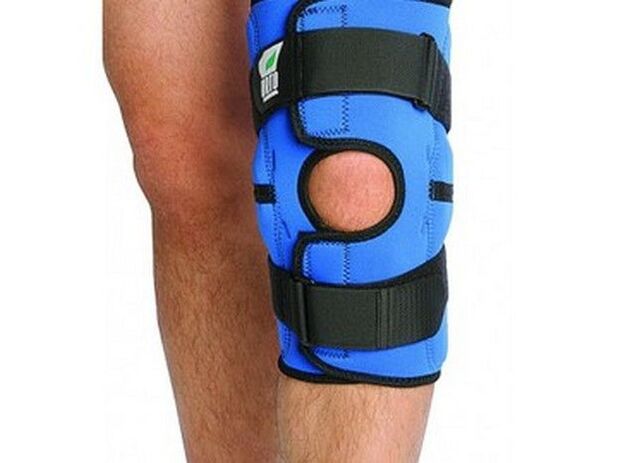
Due to the appearance of pain with any movement, a person tends to move less, which negatively affects the muscles surrounding the joint. A change in the size of the epiphyses of bones leads to a shift in the axis of the limb and the development of deformities. As the fluid volume decreases, the joint capsule becomes stiffer. When osteophytes compress the surrounding soft tissue, synovitis and chronic inflammation occur.
When moving to the 3rd stage, the signs of arthrosis of the knee joint become very severe - the pain does not go away even at night, motor skills practically stop, the leg looks crooked and does not bend. The third degree of osteoarthritis is characterized by an X- or O-shaped deformity that makes movement extremely difficult. An advanced form of deforming gonarthrosis can only be treated surgically.
diagnosis
Diagnosis of arthrosis of the knee joint is not particularly difficult; a doctor can assume gonarthrosis based on the existing symptoms and characteristic visual signs. X-rays are taken to confirm the diagnosis. The images show narrowing of the joint space, bone growth and subchondral osteosclerosis of the bones.
X-rays are used to determine the cause of the disease. Bone deformations are particularly clearly visible in post-traumatic osteoarthritis. When cartilage degeneration is caused by arthritis, defects in the edges of the bones are noted, as well as periarticular osteoporosis and atrophy of bone structures. In various congenital anomalies, axial distortion of one of the bones is observed, which leads to incorrect distribution of the load and the appearance of secondary osteoporosis.
Treatment
Treatment of gonarthrosis of the knee joint has three main goals: restoring cartilage tissue, improving mobility in the joint and slowing the progression of the disease. Great importance is placed on eliminating or weakening the symptoms – i. e. reducing the intensity of pain and inflammation. To solve these problems, medications, physiotherapy and exercise therapy are used. To achieve the maximum therapeutic effect, dosed physical activity and compliance with the orthopedic regime are required.
Drug treatment for knee osteoarthritis includes taking painkillers and anti-inflammatory drugs, as well as chondroprotectors that promote the regeneration of cartilage tissue. Medications can be prescribed in the form of injections, tablets, ointments and gels.
If first degree knee osteoarthritis is diagnosed, physiotherapeutic methods, physiotherapy and massage are used for treatment. The early stages of the disease are much easier to treat and you can expect a full recovery. An important prerequisite is losing weight to reduce the load on the painful joint.
Treatment of arthrosis of the knee joint in the second stage necessarily includes exercise therapy, wearing orthopedic aids and adherence to a diet. To relieve pain, non-steroidal anti-inflammatory drugs, chondroprotectors and intra-articular injection of hyaluronic acid are prescribed.
Acute osteoarthritis is characterized by severe pain for which conventional NSAIDs are not sufficient. In this case, strong analgesics and injection of glucocorticosteroids into the joint cavity are used.
If conservative methods remain ineffective, an operation is performed, which can be either corrective or radical (replacement of a joint with a prosthesis).
Deforming arthrosis of the knee joint in the third stage is characterized by the complete absence of the joint space, which is replaced by a bone structure. This condition requires surgical intervention, as other methods are powerless in this case.
NSAIDs and corticosteroids
In order to spare the patient physical and mental suffering, the treatment of acute osteoarthritis begins with pain relief. Medications that belong to the group of NSAIDs and can be used in tablet form or topically have proven to be effective.
The pain-relieving effect does not always occur immediately, but after two to three days it reaches its peak and the pain disappears. The duration of treatment with NSAIDs is limited to two weeks, as the risk of side effects increases with longer use. Particular caution is advised for people with gastrointestinal problems and high blood pressure.
If there is no result, hormonal medications are prescribed to relieve the inflammation. In the case of left-sided gonarthrosis, drugs are injected into the left knee and into the right knee.
Hormone injections can be given once every 10 days, not more often. The indication for such treatment is a severe accumulation of fluid in the joint due to inflammation. When symptoms subside, they switch to medication in tablet form.
Chondroprotectors and hyaluronic acid
Chondroprotective agents work in three directions: they restore damaged cartilage tissue, relieve pain and eliminate inflammatory reactions. Taking chondroprotectors helps to normalize the composition and properties of synovial fluid, nourish cartilage and protect pain receptors from irritation.
This slows the destruction of the cartilage structures and thus the progression of the disease. After taking medication, the shock-absorbing and lubricating function of the joint is restored.
In the early stages of the disease, chondroprotectors can be used in the form of an ointment or gel. However, the most effective are intra-articular injections. Modern methods of treating arthrosis involve the use of combined active ingredients that contain not only chondroprotective substances, but also anti-inflammatory components and vitamins.
Hyaluronic acid is the main component of synovial fluid and is responsible for its viscosity and consistency. This is in fact a biological lubricant that gives elasticity, elasticity and strength to the cartilage.
With the development of joint diseases, the volume of hyaluronic acid can decrease by 2-4 times, which inevitably leads to excessive friction of the bones. Due to the intra-articular injection of hyaluronic acid, the function of the knee is normalized and the person can move normally.
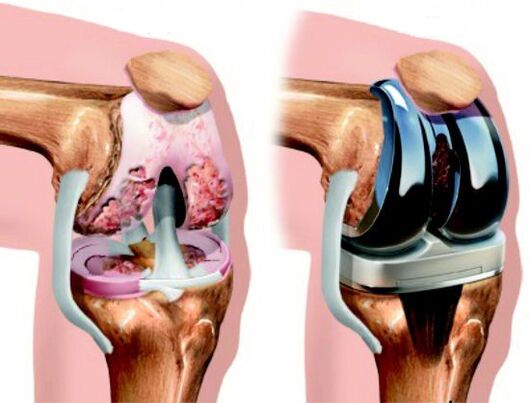
surgery
Surgery is a radical method that partially or completely restores the functionality of the joint. The degree of intervention can vary and depends on the stage of osteoarthritis. The most gentle operation is arthroscopy - the rehabilitation period after its implementation is the least painful for the patient.
Important:Arthroscopy can be performed not only for the treatment but also for the diagnosis of joint pathologies. This procedure allows you to identify damage that is not accessible to other studies.
The goal of arthroscopy is to extend the lifespan of the joint by removing dead and damaged tissue from the joint cavity. As a result, the pain disappears, resistance to stress increases and motor activity returns.
In the case of significant deformities, an osteotomy is indicated, i. e. the creation of an artificial bone fracture in a specific area. Knee osteotomy literally means "cutting through the bones" - during the operation, the surgeon removes a wedge-shaped segment of the femur or tibia and then joins the bones together in the most physiological position. If necessary, the resulting gap is filled with bone graft. During the healing phase, the structure withsecured with special clamps.
Endoprosthesis replacement is an alternative method to the outdated arthrodesis procedure, the essence of which is the partial or complete replacement of a diseased joint with a prosthesis. This completely restores knee function in more than 90% of cases, significantly improving the patient's quality of life.
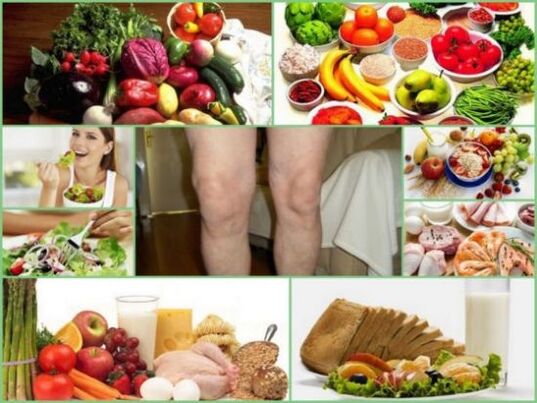
physical therapy
Physiotherapeutic procedures play an important role in the treatment of osteoarthritis due to their beneficial effect on damaged joints. Physiotherapy accelerates regeneration processes, eliminates pain and muscle cramps. In addition, certain procedures allow drugs to be administered through the skin, reducing the dosage of oral drugs.
The following techniques are recommended for damaged joints:
- magnetic field therapy;
- medium wave ultraviolet (WUV);
- infrared lasers;
- UHF;
- Ultrasonic;
- diademic and sinusoidal modulated currents (amplipulse therapy);
- Darsonval.
Effective procedures against arthrosis are also therapeutic baths - radon, hydrogen sulfide, bischofite, mineral and sage. They have an anti-inflammatory, pain-relieving and regenerating effect on the joints.
Finally
If you suspect arthrosis of the knee, you should consult an orthopedist or traumatologist who will diagnose and treat these pathologies. In order not to aggravate the disease, it is necessary to avoid excessive physical activity on the legs and get rid of excess weight.
There is no special diet for osteoarthritis, but it is recommended to avoid concentrated meat and fish broths, fatty meats and smoked meats, and also to reduce the consumption of table salt. The diet should be dominated by foods rich in vitamins and minerals and vegetable oils. In addition, it is advisable to arrange a fasting day once a week - kefir, cottage cheese or fruits and vegetables.
To strengthen the muscular corset of the lower extremities and increase blood circulation, it is necessary to regularly perform therapeutic exercises, selected individually by a physiotherapy instructor.
Therefore, taking medications, physical procedures, a balanced diet and physical exercise will definitely help a patient with arthrosis. And to avoid traumatic surgery, you should seek medical attention as early as possible. Health!



























